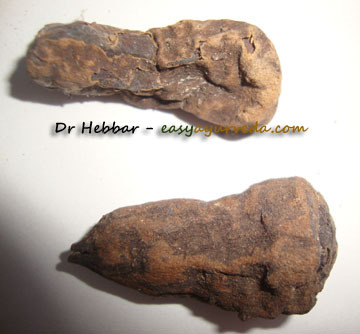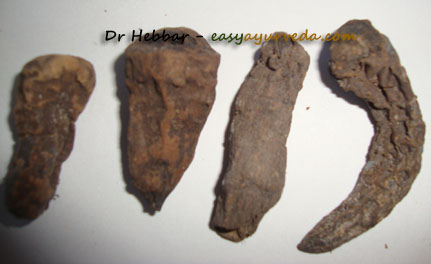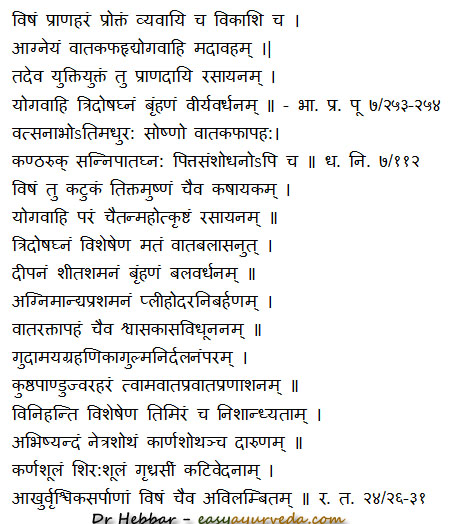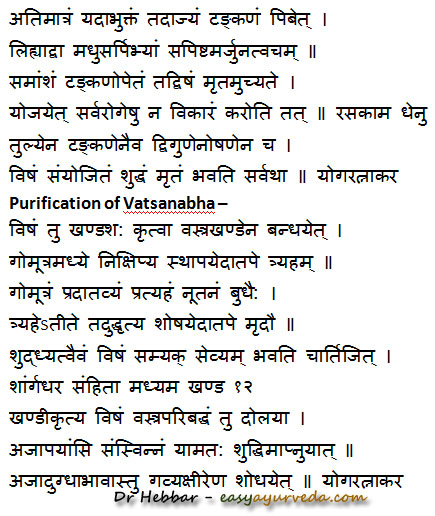Vatsanabha (Aconitum ferox) Benefits, Toxic Effects, Purification, Dose
Vatsanabha – Aconitum ferox, is an herb used as an ingredient in many Ayurvedic medicines. It is a poisonous herb, but, when used in smaller quantities, after purification, as a medicine, it has many health benefits. It is called Monk’s Hood or Monkshood in English.
Table of Contents
Botanical Name
Botanical name – Aconitum ferox Wall. ex Syringe
Family – Ranunculaceae (Vatsanabha Kula)
Varga (Group) – Visha varga (Group of toxic substances)
Kula (Family) – Vatsnabha Kula (Ranunculaceae)
Vernacular names, Sanskrit synonyms
Names in different languages:
English name – Monk’s hood, Aconite
Assamese name – Vish
Bengali name – Kathvish, Katvish, Mitha Vish
Bihari name – Dakara
Gujarati name – Basnag, Bachnag
Hindi name – Bachnag, Meetha Vish, Meetha Teliya, Vatsanabh, Bachnabh
Kannada name – Vatsanabhi
Marathi name – Bachnag
Punjabi name – Mohari, Shyam Mohari
Telugu name – Nabhi
Synonyms in Sanskrit:
Visha – poisonous herb
Amruta – Acts as nectar if used in suitable doses, after purification.
Vatsanabhi, Stokaka, Pranahara
Kshveda – Consuming it cause unconsciousness
Garala – Kills the person
वत्सनाभो वत्सनागः क्ष्वेडोऽस्त्रीच विषं मतम् ।
अमृतञ्च तदेवोक्तं रसतन्त्र विशारदैः ॥ र.त.२४/१६
vatsanābho vatsanāgaḥ kṣveḍo’strīca viṣaṃ matam |
amṛtañca tadevoktaṃ rasatantra viśāradaiḥ || ra.ta.24/16
Synonyms: Vatsanabha, Vatsanaga, Kshweda, Visha, amruta.

Classical categorization
Categorization: It is categorized under ‘Visha’ group of herbs. The word Visha in Sanskrit means poison.
Charaka – Sthavara Visha, poison of plant and mineral origin
Sushruta – Kanda Visha – tuber poisons
Bh. Pr. Ni – Dhatvadi varga
Varieties, habitat, chemical constitution
Varieties: There are many Aconitum species herbs, that are used in the name of Vatsanabha, of which Aconitum ferox is used most commonly. Some use Aconitum chasmanthum.
Habitat: Alpine zone of Himalayas of Sikkim and Chumbi.
Himalaya, Sikkim, Nepal, above 5000 feet from the sea level.
Morphology
Habit – Herb
Roots – Biennial, tuberous, dark brown externally
Stem – Erect, covered with short spreading yellow hairs in the upper part, glabrous below
Leaves – Scattered with slender petioles
Inflorescence – Raceme, Rachis slender
Flower – Slender pedicels, erect, sepals are blue, hairy, beaked, lip deflexed, lanceolate
Fruit – Follicle
Seeds – Obovoid, winged along the raphe
Useful part – Root
दैर्घ्य तु पञ्चाङ्गुलतः परं सप्ताङ्गुलोन्मितः ।
व्यासे चैकाङ्गुलात् सार्द्धद्वयङ्गुलप्रमितस्तथा ॥
आमूलचूलं क्रमशः स्थूलञ्च पाण्डुर प्रभ ।
कन्दोऽस्य भिषजां वयैर्वत्सनाभ इति स्मृतः ॥
दीर्घमूलं स्थूल कन्दं वत्सनाभविषक्षुपम् ।
उत्पाट्य शीत समये वसन्ते वा समाहरेत् ॥ र.त.२४/१२-१४
dairghya tu pañcāṅgulataḥ paraṃ saptāṅgulonmitaḥ |
vyāse caikāṅgulāt sārddhadvayaṅgulapramitastathā ||
āmūlacūlaṃ kramaśaḥ sthūlañca pāṇḍura prabha |
kando’sya bhiṣajāṃ vayairvatsanābha iti smṛtaḥ ||
dīrghamūlaṃ sthūla kandaṃ vatsanābhaviṣakṣupam |
utpāṭya śīta samaye vasante vā samāharet || ra.ta.24/12-14
Leaves similar to Nirgundi.
There will not be growth of other plants near to Vatsanabha.
Root – 5 -7 angula length and 1 – 1.5 Angula diameter. Upper part of the root is thicker than the lower part. Externally blackish, internally whitish.
Vatsanabha should be collected during Vasanta Rutu.

Aconitum ferox – Chemical constituents and pharmacology
Roots contain toxic alkaloids, pseudo-aconitine, bikhaconitine, chasmaconitine, indaconitine, etc.
Aconitine is the toxic chemical derived from this herb.
Aconitine (acetyl benzoylecgonine, C33H47NO11); Aconitum roots also contain catecholamine alkaloids, quaternary ammonium compounds, isoquinolines and other compounds.
Read more about aconitine and its toxic effects.
Suitable characteristics
स्थूलं स्निग्धं गुरू नवं फलपाकोत्तरोद्धृतम् ।
कीटाद्यभक्षितञ्चैव विषं ग्राह्यमिहोच्यते ॥ र.त.२४/१७
sthūlaṃ snigdhaṃ gurū navaṃ phalapākottaroddhṛtam |
kīṭādyabhakṣitañcaiva viṣaṃ grāhyamihocyate || ra.ta.24/17
Grahya lakshanas of Vatsanabh are –
Thick, unctuous, heavy, collected after ripening of fruit, devoid of worm infestation – such a Vatsanabha is considered as suitable for therapeutic usage.
Qualities, effect on Doshas
Aconitum ferox medicinal qualities:
Rasa (taste) – Madhura – sweet (sweet), Katu (pungent), Tikta (Bitter), Kashaya (astringent)
Vipaka – Katu – Undergoes pungent taste conversion after digestion.
Veerya – Ushna – hot in potency
Effect on Tridosha – Tridoshaghna – balances all the three Doshas, especially, balances Vata and Kapha Dosha
Uses, indications in Ayurveda
Medicinal uses of Vatsanabha as per Ayurvedic text books –
- Aconitum ferox is pungent, bitter and astringent in taste. It acts as Yogavahi – a catalyst for other medicines.
- It is rejuvenative, balances Tridosha, especially Vata and Kapha.
- It improves digestion, relieves coldness, is nutritive and improves strength.
- It is used in Ayurvedic treatment of indigestion, anorexia, spleen disorders, gout, cough, asthma.
- It is used in the treatment of vision problems, night blindness, eye infections, inflammation, otitis, headache.
- It is useful to relieve headaches, sciatica, and backache.
- It is used as an antidote for poisoning due to rats, rodents, scorpion and snake bites.

Pranahara – takes away life, poisonous, if used without purification procedure.
Vyavayi – Upon ingestion, spreads to all parts of the body, swiftly
Vikashi – Loosens joints (a quality of poison and alcohol)
Agneya – hot in potency, its action mimics fire
Yogavahi – acts as a catalyst for other herbal ingredients to deliver swift therapeutic action.
Brumhana – improves nourishment
Veeryavardhana – improves sperm quality and quantity
Kantharuk – useful in throat disorders
Sannipataghna – useful in chronic fever, last stage of fatal disorders
Rasayana – rejuvenating, anti aging
Deepana – improves digestion strength
Balavardhana – improves strength and immunity
Agnimandyahara – relieves indigestion, low digestion strength
Pleehodara – useful in splenomegaly, enlarged spleen
Vataraktahara – useful against gout
Shwasahara – useful in asthma, COPD and other respiratory diseases
Kasahara – relieves cough, cold
Gudamayahara – useful in piles, fistula and such other ano-rectal disorders
Grahanihara – useful against IBS, mal-absorption syndrome, alternate loose and hard stools
Gulmahara – useful in abdominal tumor
Kushtahara – useful in skin diseases
Panduhara – useful in anemia, first stage of liver disorders
Jwarahara – useful in fever
Amavatahara – useful in rheumatoid arthritis
Vataghna – Balances Vata, useful in neurological disorders such as paralysis, hemiplegia, neuropathy etc
Timirahara – useful in eye disorder
Nishandhyahara – useful in night blindness
Abhishyanda – useful in conjunctivitis
Netrashotha – relieves eye swelling
Karnashotha – relieves ear swelling
Karnashoolahara – useful in ear ache
Shirashoolahara – useful in headache
Grudhrasi – useful in sciatica
Kativedana – relieves lower back pain, hip pain
Akhu, Vrushchika, Sapra vishahara – Useful in rodent bite, scorpion bite and snake bite.
Part used, Dosage
Part used: Tuberous root of Vatsanabhi.
It is best to collect roots of Aconitum ferox between December to April. During this period, Vatsanabha will be more potent.
Dosage:
भक्षयेद्राजिका वृद्ध्या यावद्गुञ्जा मितं भवेत् ।
यवमात्रं ग्रसेत् सुस्थो गुञ्जा मात्रं तु कुष्ठवान् ॥ (र.र.स. २९/२३)
bhakṣayedrājikā vṛddhyā yāvadguñjā mitaṃ bhavet |
yavamātraṃ graset sustho guñjā mātraṃ tu kuṣṭhavān || (ra.ra.sa. 29/23)
Dose: 1 Sarshapa – 1 Ratti (125 mg)
This herb should always be used only after the purification process.
The dose of purified Vatsanabha is – 60 – 125 mg
Fatal dose and Fatal Period
1gm (Root), 250 mg (Extract), 4 mg (Alkaloid)
Fatal period – 20 minutes to 24 hrs. Average is 6 hrs
Toxic effects
Toxic effects of Aconitum ferox according to Ayurveda –
Sushruta has explained Torticollis (neck stiffness) and yellowish discoloration of eyes, stools and urine as toxic effects of Vatshanabhi.
The textbook Rasaratna Samucchaya explains 8 stages of toxic effects of Vatsanabha. These stages refer to the spreading of poison in different parts of the body. These stages are also dependent on the level of toxicity and dosage of Vatsanabha.
- 1st stage – Twak Vikara – skin rashes,
- 2nd stage – Vepathu – tremors
- 3rd stage – Daha – burning sensation all over the body.
- 4th stage – Vikrata – deformity
- 5th stage – phenodgati – frothing
- 6th stage – skandha bhanga – drooping and wasting of shoulders.
- 7th stage – Jadyata – wasting and comatose the whole body.
- 8th stage – Marana – death.
Necessity for purification of Vatsanab
अविशुद्धं विषं दाहं मोहं हृद्गतिरोधनम् ।
मृत्युञ्च विदधात्याशु तस्मात्तं परिशोधयेत् ॥ र.त.२४/१८
aviśuddhaṃ viṣaṃ dāhaṃ mohaṃ hṛdgatirodhanam |
mṛtyuñca vidadhātyāśu tasmāttaṃ pariśodhayet || ra.ta.24/18
If used without purification, Vatsanabha will cause burning sensation, confusion, hampers cardiac activity and leads to death.
Treatment of poisonous effect of Vatsanabha
क्षीर क्षौद्र घृतैर्युक्तं पीतं हन्ति विषं विषम् । र.र.स. २९/३३
kṣīra kṣaudra ghṛtairyuktaṃ pītaṃ hanti viṣaṃ viṣam | ra.ra.sa. 29/33
Cow milk mixed with honey, purified Vatsanabha choorna.
नरमूत्रं विषं हन्ति ।(सुश्रुत)
naramūtraṃ viṣaṃ hanti |(suśruta)
The effect of poison gets destroyed by consuming Human urine.
By using Sarpakshi Swarasa, Tankana and Ghee, bad effects of poison gets subsided.
Give such a quantity of Ajadugdha that there is a vomit.
Drink ajadugdha (goat milk) until you vomit, if there is no vomiting of goat milk, then it should be considered that the effect of the poison has been destroyed.
Management of toxicity of Vatsanabh:
- Cow milk mixed with honey, purified Vatsanabha choorna.
- Human urine
- Sarpakshi swarasa + Tankana + ghee
- Vamana with Ajadugdha.
Antidotes for Vatsanabha poisoning
The treatment for Vatsanabha is possible upto 5th stage only. – (Rasaratna Samucchaya)
a. During Aconitum ferox toxicity due to over-dosage or usage without purification procedure, ghee along with Tankana bhasma is given.
b. Combination of Honey, ghee and bark of Arjuna (Terminalia arjuna) is also used as an antidote.
c. Whenever Vatsanabha is used in any formulation, Tankana Bhasma (Borax calx) is always used in equal quantities. If used so, it will nullify all the toxic effects of Vatsanabha and hence there will not be any toxic effects.
Example: Tribhuvana Kirti Ras – a potent Ayurvedic medicine used in fever, has both Vatsnabha and Tankana.
d. Vatsnabha used with equal quantity of Tankana (purified borax) and double quantity of black pepper (Maricha / Ushana) will not have any toxic effects.

Purification procedure – Vatsanabha Shodhana
One among the following methods is followed for detoxification of Vatsanabha.
1. Aconitum ferox root is tied in a piece of cloth, kept dipped in cow urine. It is exposed to sunlight for three days. Each day, cow urine is replaced with fresh one. After the third day, it is dried and preserved.
2. Aconitum ferox roots are made into pieces, tied in a piece of cloth, suspended in goat milk or cow milk, and heated for three hours.
3. Vatsanabha, kept dipped in cow urine for three days, gets purified.
4. Vatsanabha is boiled by suspending it in Triphala decoction for three hours.
अथ गोमूत्रसंयुक्तमातपे शोषयेत्त्र्यहम् ।
विषं बृहंणमेतद्धि विषस्यादौ प्रशस्यते ॥ र.र.स.२९
atha gomūtrasaṃyuktamātape śoṣayettryaham |
viṣaṃ bṛhaṃṇametaddhi viṣasyādau praśasyate || ra.ra.sa.2
Vatsanabha is made into small pieces, taken in a mud pot.
Filled with cow urine till all the particles of Vatsanabha are completely dipped in cow urine.
This pot is exposed to bright sunlight for 3 days. Each day, old cow urine is replaced with fresh cow urine.
On the fourth day, Vatsanabha is taken out, skin is removed, washed with hot water, dried and preserved.
विषं चणकसंस्थानं कृत्वा पोट्टलिकागतम् ।
सुरभीपयसा चेह दोलिकायन्त्रयोगतः ॥
यामद्वयं वा यामैकं स्वेदयेदतियत्नतः ।
संशोधितं विषं त्वेवं विशुद्ध्यति न संशयः ॥ र.त.२४/२३-२४
viṣaṃ caṇakasaṃsthānaṃ kṛtvā poṭṭalikāgatam |
surabhīpayasā ceha dolikāyantrayogataḥ ||
yāmadvayaṃ vā yāmaikaṃ svedayedatiyatnataḥ |
saṃśodhitaṃ viṣaṃ tvevaṃ viśuddhyati na saṃśayaḥ || ra.ta.24/23-24
Vatsanabha is cut into small pieces, tied in a cloth, Swedana is done in Goksheera for 6 hours, washed with hot water, dried and preserved.
खण्डीकृतो वत्सनाभः पोट्टलिगर्भसंस्थितः ।
अजादुग्धेन सुस्विन्नो यामतः शुद्धिमाप्नुयात् ॥ र.त.२४/२५
khaṇḍīkṛto vatsanābhaḥ poṭṭaligarbhasaṃsthitaḥ |
ajādugdhena susvinno yāmataḥ śuddhimāpnuyāt || ra.ta.24/25
Vatsanabha can also be purified by Swedana in Aja Ksheera for six hours.
Marana of Vatsanabha
समटङ्कण सम्पिष्टं तद्विषं मृतमुच्यते ।
योजयेत्सर्वरोगेषु न विकारं करोति च ॥” आ.प्र.५/६०
samaṭaṅkaṇa sampiṣṭaṃ tadviṣaṃ mṛtamucyate |
yojayetsarvarogeṣu na vikāraṃ karoti ca ||” ā.pra.5/60
Shuddha Vatsanaba is mixed with equal parts of Shuddha Tankana and triturated for 1 Prahara. Tankana is an antidote for Vatsanabha. Hence, by this method, the toxic effects of Vatsanabha gets nullified.
Research
Evaluation of toxicity – Thin Layer Chromatography studies were conducted on Vatsanabha. Before and after purification readings were taken and compared. Studies showed that pseudoaconitine and aconitine were converted into far less toxic substances like veratroyl pseudoaconine and benzoylaconine respectively only in traditional Ayurvedic Shodhana.
Phyto-sociological features – This study concluded that the availability of Aconitum ferox and A. heterophyllum has decreased in alpine and subalpine regions of Kumaun Himalaya.
Indications, side effects, contraindications
- While taking Vatsanabha, it is better to follow Abstinence. One should take cow’s milk, ghee, honey, sugar and rice.
- All those food articles that cause an increase of Pitta, like hot and pungent, sour, salty food stuff, should be avoided.
- It should not be taken during summer and rainy season, (where there are chances of Pitta increase).
- It should be avoided in people with Pitta symptoms like – who are very angry, who have excessive thirst, hunger, excessive sun exposure, who have walked for long.
- Sleeping in daytime should be avoided.
- It is contraindicated in pregnancy, lactation, and in early childhood, patients of cardiac, liver, kidney and brain diseases.
- Vatsanabha can get absorbed through skin (subcutaneous absorption). Hence, it should be handled very carefully.
Properties of shuddha Vatsanabha
विषं तु कटुकं तिक्तमुष्णं चैव कषायम् ।
योगवाहि परं चैतन्महोत्कृष्टं रसायनम् ॥
त्रिदोषघ्नं विशेषेण मतं वातबलासनुत् ।
दीपनं शीतशमनं बृंहणं बलवर्धनम् ॥
अग्निमान्द्यप्रशमनं प्लीहोदरनिर्वहणम् ।
वातरक्तापहं चैव श्वासकासविधूननम् ॥
गुदामयग्रहणिकागुल्मनिर्दलं परम् ।
कुष्ठपाण्डुज्वरहरं त्वामवातप्रणाशनम् ॥
विनिहन्ति विशेषेण तिमिरं च निशान्धताम् ।
अभिष्यन्दं नेत्रशोथं कर्णशोथञ्च दारुणम् ॥
कर्णशूलं शिरशूलं गृध्रसीं कटिवेदनाम् ।
आखुवृश्चिकसर्पाणां विषं चैवाविलम्बितम् ॥
viṣaṃ tu kaṭukaṃ tiktamuṣṇaṃ caiva kaṣāyam |
yogavāhi paraṃ caitanmahotkṛṣṭaṃ rasāyanam ||
tridoṣaghnaṃ viśeṣeṇa mataṃ vātabalāsanut |
dīpanaṃ śītaśamanaṃ bṛṃhaṇaṃ balavardhanam ||
agnimāndyapraśamanaṃ plīhodaranirvahaṇam |
vātaraktāpahaṃ caiva śvāsakāsavidhūnanam ||
gudāmayagrahaṇikāgulmanirdalaṃ param |
kuṣṭhapāṇḍujvaraharaṃ tvāmavātapraṇāśanam ||
vinihanti viśeṣeṇa timiraṃ ca niśāndhatām |
abhiṣyandaṃ netraśothaṃ karṇaśothañca dāruṇam ||
karṇaśūlaṃ śiraśūlaṃ gṛdhrasīṃ kaṭivedanām |
ākhuvṛścikasarpāṇāṃ viṣaṃ caivāvilambitam ||
Tikta Kashaya rasa, Ushna Veerya.
Yogavahi, Rasayana, Tridoshaghna, especially Vatakaphahara.
Deepana, Balya, Bruhmana,
Useful in the treatment of
Agnimandya – dyspepsia,
Pleeha – splenic disorders,
Udara – ascites,
Vatarakta – gout,
Shwasa – dyspnea,
Kasa – cough,
Gudaroga – diseases pertaining to anal canal and rectum,
Grahani – malabsorption syndrome,
Gulma – abdominal tumor,
Kushta – skin diseases,
Pandu – anemia,
Jwara – fever,
Timira – senile cataract,
Nisha andhya – night blindness,
Abhishyanda – conjunctivitis,
Netrashotha – inflammation of eye,
Karnashotha – inflammation of ear,
Karnashoola – otalgia,
Shirashoola – headache,
Katishoola – back pain,
Gridhrasi – sciatica,
Bite of scorpion, rat and snake.
Interaction with medicines, supplements
Can this be used while taking Homeopathic medicine?
Yes. This product does not react with homeopathic medicine.
Can this medicine be continued while taking supplements like multivitamin tablets, Omega 3 fatty acids etc?
Yes. Generally, this product goes well with most dietary supplements. However, if you are taking more than one product per day, please consult your doctor for an opinion.
With western
medicines
Seek your
doctor’s advice if you are taking this product along with other western
(allopathic / modern) medicines. Some Ayurvedic herbs can interact with modern
medicine.
If both Ayurvedic and allopathic medicines are advised together, then it is
best to take Allopathic medicine first, wait for 30 minutes and then take the
Ayurvedic medicine.
Ayurvedic medicines
Important Ayurvedic medicines with Vatsanabha as ingredient:
Tamra parpati – used in the treatment of anemia, skin diseases etc
Sanjivani Bati – used in Ayurvedic treatment of dyspepsia, indigestion, gastro-enteritis etc
Tribhuvan Kirti Ras – used in the treatment of acute and chronic fever.
Kaphaketu Ras – used in the treatment of rhinitis, cough, cold, Asthma etc.
Ananda Bhairava Rasa
Mrityunjaya rasa
Hinguleshvara rasa
All the precautions, side effects and antidotes of Vatsanabha also apply to medicines prepared with it.
Proprietary Ayurvedic medicines containing Bachnag as ingredient:
Feverun Capsule manufactured by Mukti Pharma. It reduces body temperature in fever.
Substitutes
Aconitum laciniatum
Aconitum denorrhizum
Aconitum falconeri
Aconitum spicatum
Aconitum violaceum
Identification
सिन्धुवारसदृक्पत्रो वत्सनाभ्याकृतिस्तथा ।
यत्पार्श्वे न तरार्वॄद्धिः वत्सनाभ स उच्यते ॥ भा.प्र.
sindhuvārasadṛkpatro vatsanābhyākṛtistathā |
yatpārśve na tarārvṝddhiḥ vatsanābha sa ucyate || bhā.pra.
One whose leaf is like that of Sindhuvara, whose shape is similar to that of navel of a calf, near which no other plant grows, should be considered as Vatsanabha.
Types
कृष्णाभ कपिशः पाण्डुर वर्णतस्त्रिविधो मतः ।
वत्सनाभो विशेषेण क्रमेण गुणवत्तमः ॥ र.त. २४/१५
kṛṣṇābha kapiśaḥ pāṇḍura varṇatastrividho mataḥ |
vatsanābho viśeṣeṇa krameṇa guṇavattamaḥ || ra.ta. 24/15
Krishnabha – blackish,
Kapisha – brownish
and Pandura – pale white.
Pandura variety is the greatest.
Sthanika karma (Action on different system)
External application- its external application relieves pain, and oedema. Nerve stimulant, Indicated in joint inflammation, low back ache, headache etc.
Nervous System – It has vyavayi, vikashi action, in lower dose it stimulates sensory nerves Overdose may lead to weakening of the nervous system. Indicated in Hemiplegia, paraplegia, and other degenerative nervous disorders
Digestive system – Cause numbness of tongue. As it triggers nerve endings it stimulates saliva production, and causes horripilation. Therapeutically it can be used to stimulate taste buds. It has carminative, digestive, and analgesic action. It can cause numbness of nerve endings of the stomach, thus reducing the production of digestive enzymes. Indicated in Loss of Appetite, stomach related disorders, cramp, and disorders of liver and spleen.
Circulatory System – Unpurified Vatsanabha slows down the heart function. but purified Vatsanabha stimulates the heart, increases blood pressure. Indicated in weakness of heart,
pulmonary edema, swelling of trachea, pericardium, or heart region
Respiratory System – Pacify Kapha dosha and in lower doses. It stimulates the respiratory system. Indicated in Cough, dyspnea.
Excretory system – Increases urine output., indicated in urinary incontinence due to weakness of nerves, urinary calculi and in Ikshumeha
Reproductive System – act as shukrasthambaka. Indicated in premature ejaculation, stimulates menstrual flow.
Satmikarana – In lower does it promote strength.
Tapakrama – Indicated in fever, skin disorders











16 comments
Vaidya N.T.Pathak
aconitum has cardiac sedative action so it shold not be given in more then 25mg at a time .otherwise it can make a TIA which may be fatal.
BC Menon
Why Dr. Hebbar, always hesitate to write Malayalam Name of herbals.
Dr J V Hebbar MD(Ayu)
I only write what I know. You can help me 🙂
Dr.SreeHari Kovi
sir is there any reason for not having tankana in hinguleswara rasa formulation?
Dr J V Hebbar MD(Ayu)
Hi, I do not have specific reason for it. Usually Vatsanabha with tankana is used in combination.
Probably, Pippali with Hingula would nullify any adverse effects of Vatsanabha.
Dr.SreeHari Kovi
thank you sir
kaleem shahid
Kiya bachhnag ko him nembu k Ras se 6 hours boiled kar me detoxify kar sakte hain
Dr Malini Bhat
Nahi Sir.
S.S. Irfan
Vatsanabha is boiled by suspending in Triphala decoction for three hours.
Quantity of Triphala decoction is not mentioned?
Dr J V Hebbar MD(Ayu)
Hi quantity of Triphala decoction depends on the size of vessel and the size of the vatsanabha pack. it should be sufficient enough to completely immerse the Vatsanabha pack.
While boiling, due to evaporation, if the quantity of decoction reduces, then some more decoction is added into the vessel (pot) again.
Dr J V Hebbar MD(Ayu)
I do not think it grows in the said places.
Jai
If someone is taking this herb for eczema and psoriasis but has high pitta as well, any suggestion for a cooling herb to go with it? Or taking it with dahi/yogurt should be cooling enough. Please suggest?
Dr J V Hebbar MD(Ayu)
Regular consumption of half – 1 cup of milk or sweet Dahi is good to cool down the body.
Vaishnavi. Am.
Is vatsanabha increases blood pressure in htn patients
Pratiksha Gajbhiye
How Vatsanabha is used in headache?
Dr J V Hebbar MD(Ayu)
It is useful in headache associated with fever or sinusitis.